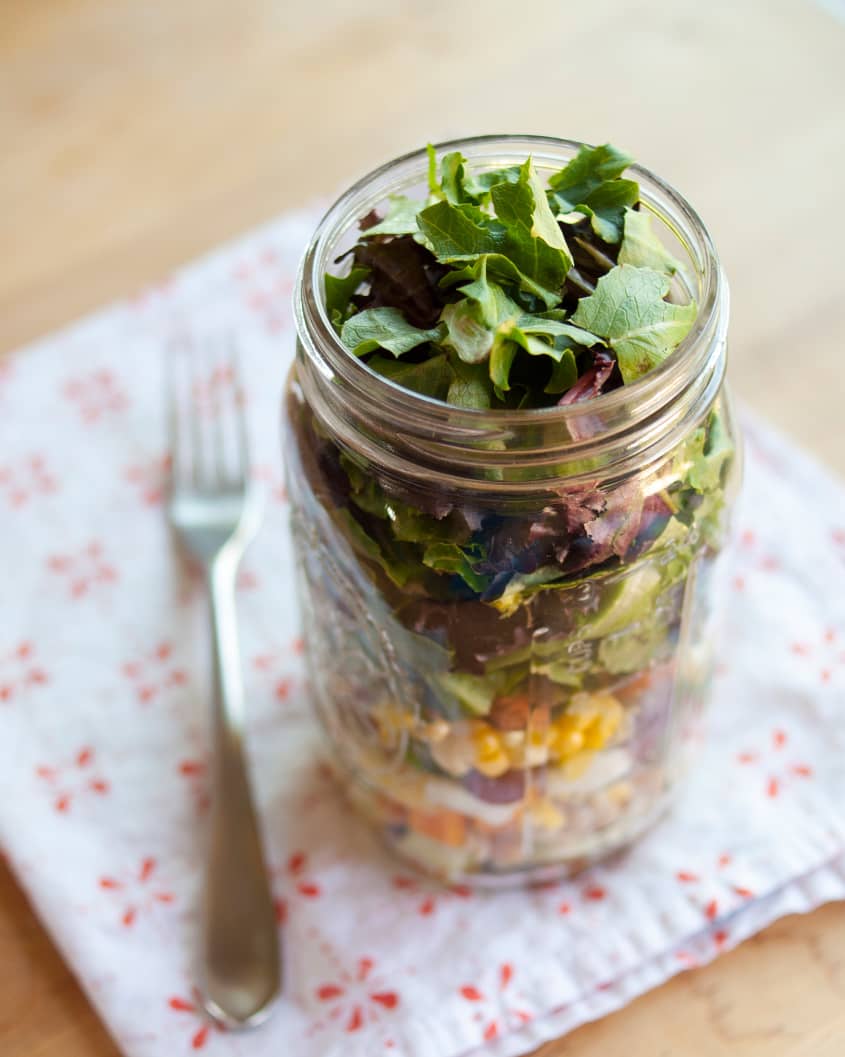Grab-n-Go Jar Salads

Prep Time
30 minutes
Prep Notes
By far one of my most favorite ways to use pint- and quart-sized canning jars is to pack them with salads. Yes, that’s right, leafy green salads. Dressing goes on the bottom, veggies and other salad goodies get piled on top. Everything stays separate and dressing-free until you toss the salad together in the bowl — never eat another soggy lunch salad again. Even better, these salads last for days in the fridge so we can make a week’s worth of lunches ahead of time.
How do you keep the greens from getting soggy?
The basic idea when packing salads in jars is to start with the heaviest and most non-absorbent ingredients with the dressing on the bottom of the jar and work your way up through the lighter ingredients until you end up with the salad greens themselves. As long as your jar doesn’t accidentally tip over in the bag, the delicate greens will be well-protected from the dressing until you’re ready to eat them.
The best jar to use?
Any canning jar can be used, but wide-mouthed jars are the easiest for both packing the salad into the jars and shaking them out again. Pint-sized jars are great for individual side salads of mostly greens with just a few “extra” salad toppings. Use quart-sized jars for larger lunch and dinner salads that have a lot of extra veggies and salad goodies. Two-quart jars (or larger) are great if you’re taking the salad to a potluck or cookout.
How long will the jarred salad keep in the fridge?
With the lid sealed tightly, these salads can last for several days in the fridge — up to five days or so. If you’re making salads with soft ingredients or perishable proteins, like avocados, tomatoes, hard-boiled eggs, or cooked chicken breast, wait to add those ingredients until the day you plan to eat the salad.
Cooking Time
0
Yields
1 serving per small jar
Ingredients
Dressing: Goes in first. 1-4Tbs of favorite dressing or homemade dressing. Try to stay away from creamy dressings which don't seem to keep as well.
Hard Vegetables: hard chopped vegetables you're including in your salad, like carrots, cucumbers, red and green peppers, cooked beets, and fennel.
Beans and Grains: beans, grains; like chickpeas, black beans, cooked barley, or farro, cooked brown rice
Cheese or Proteins (Optional): If you'll be eating the salad within the day, add a layer of diced or crumbled cheese and proteins like tuna fish, diced (cooked) chicken, hard-boiled eggs, or cubed tofu. If you're making salads ahead to eat throughout the week, wait to add these ingredients until the day you're planning to eat the salad and add them on top of the jar.
Softer vegetables and fruits (optional): soft vegetables or fruits, like avocados, tomatoes, diced strawberries, or dried apricots. If you're making salads ahead to eat throughout the week, wait to add these ingredients until the day you're planning to eat the salad and add them to the top of the jar.
Nuts, seeds, and lighter grains: any nuts or seeds, like almonds, walnuts, and sunflower seeds. If you're making a salad with lighter, more absorbent grains like quinoa or millet, add them in this layer instead of with the beans.
Salad greens: Last but not least, fill the rest of the jar with salad greens. Use your hands to tear them into bite-sized pieces. It's fine to pack them into the jar fairly compactly.
Directions
Add all ingredients in the order of the list above.
Screw the lid on the jar and refrigerate for up to 5 days. If you're including any cheese, proteins, or soft fruits and vegetables, add these to the top of the jar the morning you plan to eat your salad.
When ready to eat, unscrew the lid and shake the salad into the bowl. The action of shaking the salad into the bowl is usually enough to mix the salad with the dressing. If not, toss gently with a fork until coated.
Notes
EQUIPMENT
Wide-mouth canning jars with tight-fitting lids: pint jars for side salads, quart jars for individual meal-sized salads, 2-quart jars (or larger) for multiple servings
Large bowl, to serve
Credit
Emma Christensen, former editor for The Kitchn
